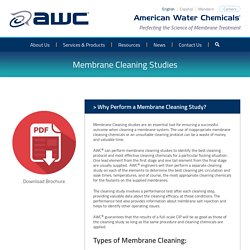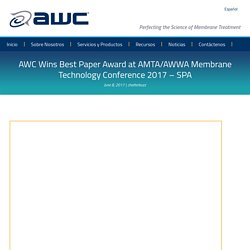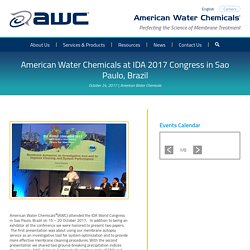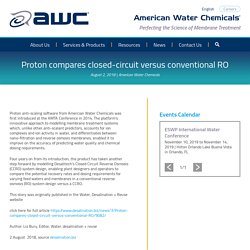

Membrane Cleaning Studies. Membrane Cleaning studies are an essential tool for ensuring a successful outcome when cleaning a membrane system.

The use of inappropriate membrane cleaning chemicals or an unsuitable cleaning protocol can be a waste of money and valuable time. AWC® can perform membrane cleaning studies to identify the best cleaning protocol and most effective cleaning chemicals for a particular fouling situation. One lead element from the first stage and one tail element from the final stage are usually supplied. Proton® Antiscalant Software. Why was AWC’s new antiscalant software named PROTON®?

Protonation is the acceptance of acid protons from the surrounding solution, while deprotonation is the donation of acid protons to the surrounding solution. The name PROTON® was selected because all the calculations in the software, whether for scale saturation, or for salt rejection, are based on protonation and deprotonation of weak acids, bases and ion complexes in the Reverse Osmosis/Nanofiltration (RO/NF) process. How can PROTON® help me with system design?
PROTON® allows the user to compare the required feed pressure and permeate water quality for various membranes under identical conditions. AWC Wins Best Paper Award at AMTA/AWWA Membrane Technology Conference 2017 - SPA. AWC is proud to announce that our CEO and Technical Director, Mo Malki, won the AMTA Best Paper Award at the MTC 2017 conference in Long Beach, California.

The paper, titled “A Novel Calcium Carbonate Scaling Model for Calculating Maximum Recovery and Inhibitor Dosages in Industrial RO Applications” described three indices developed by American Water Chemicals. The first index is a saturation index, named the Calcium Carbonate Nucleation Index (CCNI), accounts for ion complexes and ionic activity in addition to temperature and pH. The second index, the Antiscalant Precipitation Index (API), calculates the limitations of RO antiscalants due to their interaction with calcium, magnesium and alkalinity at any given pH. AWC® supports RO chemicals distributors at Expo Pack 2017 in Guadalajara. American Water Chemicals® (AWC) joined Water Technologies de Mexico at the Expo Pack conference in Guadalajara Mexico June 13 – 15.

We at AWC are proud to support our partners to share our ongoing research in using our RO antiscalants, membrane cleaners, and our groundbreaking laboratory techniques to solve complex problems. As we develop new knowledge of scaling chemistry and scale inhibitors we continue to share our experience with clients around the globe.
Attending this conference were approximately 15,000 professionals involved in packaging and processing from industries such as food, beverage, pharmaceutical, cosmetics & personal care, graphic arts, chemical, household chemicals, textile, footwear, automotive, hardware, furniture and electronics. fr AWC’s PROTON® Man continues to evolve as he tackles increasingly complex systems design, water constituents, and previously not so understood precipitation mechanisms. AWC wins vendor award from Membrane association. American Water Chemicals at IDA 2017 Congress in Sao Paulo, Brazil.
American Water Chemicals®(AWC) attended the IDA World Congress in Sao Paulo, Brazil on 15 – 20 October 2017.

In addition to being an exhibitor at the conference we were honored to present two papers. The first presentation was about using our membrane autopsy service as an investigative tool for system optimization and to provide more effective membrane cleaning procedures. With the second presentation we shared two ground-breaking precipitation indices developed by AWC: Calcium Carbonate Nucleation Index (CCNI) and Antiscalant Precipitation Index (API).
CCNI was developed to predict scaling potential in membrane systems that more accurately predicts spontaneous nucleation and maximum system recovery. API predicts the failure point for antiscalants which can precipitate as calcium or magnesium salts. Reverse Osmosis Membrane - Understanding Alkalinity and its Impact. Alkalinity is Vital for Reverse Osmosis and Nanofiltration Membrane Plant Operators The word “alkalinity” is probably one of the most commonly used in our industry.

The United Nation notes 2019 will be the year of the periodic table. Record set for Most wastewater recycled to drinking water. Closed-Circuit Versus Conventional RO. Proton anti-scaling software from Amercian Water Chemicals was first introduced at the AMTA Conference in 2014.

The platform’s innovative approach to modelling membrane treatment systems which, unlike other anti-scalant predictors, accounts for ion complexes and ion activity in water, and differentiates between nano-filtration and reverse osmosis membranes, enabled it to improve on the accuracy of predicting water quality and chemical dosing requirements. Four years on from its introduction, the product has taken another step forward by modelling Desalitech’s Closed Circuit Reverse Osmosis (CCRO) system design, enabling plant designers and operators to compare the potential recovery rates and dosing requirements for varying feed waters and membranes in a conventional reverse osmosis (RO) system design versus a CCRO.
At Aquatech Mexico. AWC® participates in ALADYR Congress-American Water Chemicals, Inc. Why RO Chemicals and RO Antiscalants Matter. Reverse osmosis chemicals, or RO Chemicals, and RO antiscalants are specialty chemicals that are added upstream of a reverse osmosis membrane system.

These reverse osmosis chemicals are designed to prevent or slow-down mineral scale formation on the membrane surface. For this reason, the right antiscalant is critical for the consistent operation of a reverse osmosis system. Mineral scale is formed when the dissolved minerals in water are allowed to concentrate to beyond their saturation limit, where they will start to come out of solution. Similar to water spots on a window, the water sprayed on the window appears clear but there are dissolved minerals in each drop. As that water evaporates the dissolved minerals stay behind and show themselves as a hard water spot.